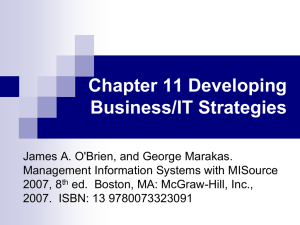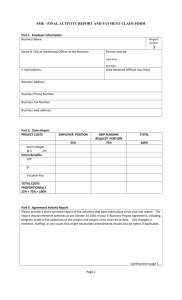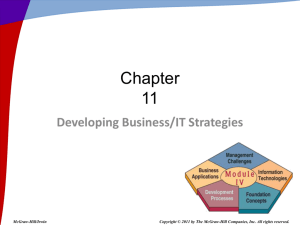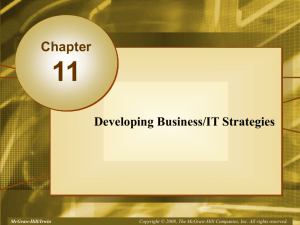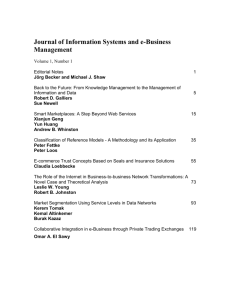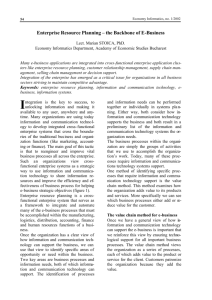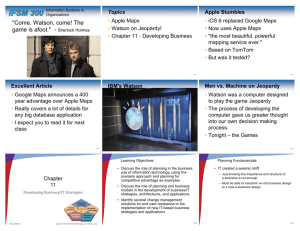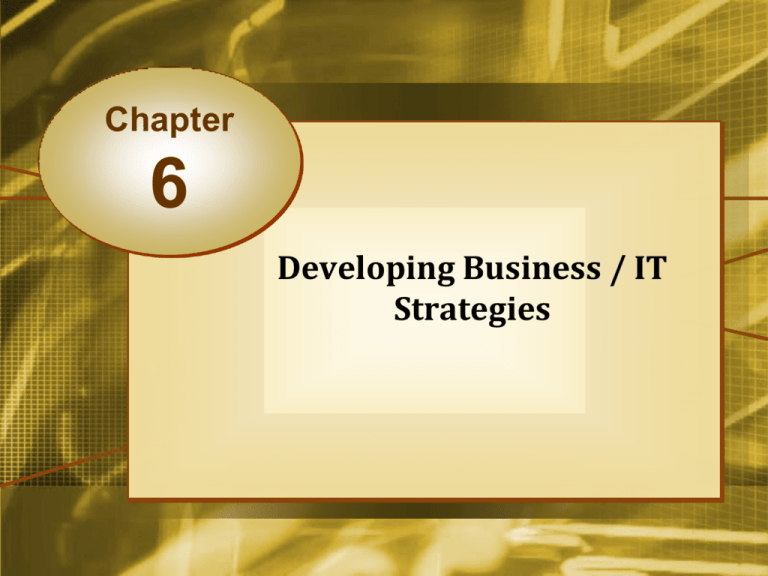
Chapter
6
Developing Business / IT
Strategies
McGraw-Hill/Irwin
Copyright © 2008, The McGraw-Hill Companies, Inc. All rights reserved.
Learning Objectives
• Discuss the role of planning in the business
use of information technology, using the
scenario approach and planning for
competitive advantage as examples
• Discuss the role of planning and business
models in the development of business/IT
strategies, architectures, and applications
• Identify
several
change
management
solutions for end user resistance to the
implementation of new IT-based business
strategies and applications
2-2
Chapter Highlight
•
•
•
•
•
•
•
•
•
•
Introduction
Planning for competitive advantage
Business models and planning
Business / IT architecture planning
Identifying business / IT strategies
Implementation challenges
Implementation IT
End user resistance & involvement
Change management
A change management process
2-3
INTRODUCTION
• Information technology has created a seismic
shift in the way companies do business
• Just knowing the importance and structure of
e-business is not enough
• You must create and implement an action plan
that allows you to make the transition from an
old business design to a new e-business design
2-4
ORGANIZATIONAL PLANNING
• Figure 6.1 illustrates the components of an
organizational planning process such as:
• Team building, modeling and consensus
• Evaluating what an organization has accomplished
and the resources they have gain
• Analyzing their business, economic, political and
common environments
• Anticipating and evaluating the impact of future
developments
• Building a shared vision and deciding on what goals
they want to achieve
• Deciding which actions to take to achieve their goal
2-5
Components of Organizational Planning
2-6
• The result of this process is what we call a plan,
which formally articulates the actions we feel are
necessary to achieve our goal. Thus,
• A plan is an action statement
• Plan lead to actions
• Actions produce results and part of planning is
learning from results
• In this context, the planning process is followed
by implementation, which is monitored by control
measures, which provide feedback for planning.
2-7
Planning
• Strategic Planning
• Deals with the development of an organization’s
mission, goals, strategies, and policies
• Begins with strategic visioning questions
• Tactical Planning
• The setting of objectives and the development
of procedures, rules, schedules, and budgets
• Operational Planning
• Done on a short-term basis to implement and
control day-to-day operations
2-8
• The Scenario Approach
• Gaining in popularity as a less formal, but more
realistic, strategic planning methodology
• Teams of managers and planners participate
• Business scenarios are created and evaluated
• Alternative scenarios are then created
2-9
Planning for Competitive Advantage
• Planning for competitive advantage is especially
important in today’s competitive business arena and
complex information technology environment.
• Strategic business/IT planning
• Involves evaluating the potential benefits
and risks of using IT-based strategies and technologies for
competitive advantage
• The following models can help generate ideas for
the strategic use of IT to support initiatives
• Competitive forces(competitors, customers, suppliers,
new entrants and substitutes)
• Competitive strategies (cost leadership, differentiation.
Growth, innovation and alliances)
2-10
• Value chain
• Basic business activities
• These models can be used in a strategic planning
process to help generate ideas for the strategic use of
IT to support new e-business initiatives.
2-11
• SWOT Analysis
• Is used to evaluate the impact that each possible
strategic opportunity can have on a company and
its use of IT.
• Strengths: a company’s core competencies
and resources
• Weaknesses: areas of substandard business
performance compared to others
2-12
• Opportunities: potential for new business
markets or innovative breakthroughs that
might expand current markets
• Threats: anything that has the potential for
business and market losses
2-13
BUSINESS MODELS AND PLANNING
• A business model is a conceptual framework that
express the underlying economic logic and
system that prove how a business can deliver
value to customers at an appropriate cost and
make money.
• Business model answers vital questions about
the fundamental components of a business
•
•
•
•
Who are our customers?
What do our customers value?
How much will it cost to deliver that value?
How do we make money in this business?
2-14
BUSINESS / IT ARCHITECTURE PLANNING
• The business/IT planning process, which focuses on
discovering innovative approaches to satisfying a
company’s customer value and business value goals.
• This planning process leads to development of
strategies and business models for new e-business
and e-commerce platforms, processes, products and
services.
• Then a company can develop IT strategies and an IT
architecture that supports building and implementing
its newly planned business applications.
2-15
• The business / IT planning process has three
major components:
• Strategic development
• Resource management
• Technology architecture
2-16
• Strategic development
• Developing business strategies that support a company’s
business vision, for example, using IT to create innovative
e-business systems that focus on customer and business
value.
• Resource management
• Developing strategic plans for managing or outsourcing a
company’s IT resources, including IS personnel,
hardware, software, data and network resources.
2-17
• Technology architecture
• Making strategic IT choices that reflect an
information technology architecture designed to
support a company’s e-business and other
business / IT initiatives.
2-18
IDENTIFYING BUSINESS / IT
STRATEGIES
• Internet technologies and e-business and ecommerce applications can be used strategically
for competitive advantage.
• However, in order to optimize this strategic
impact, a company must continually assess the
strategic value of such applications:
• Cost and efficiency improvements
• Performance
improvement
in
effectiveness
• Global market penetration
• Product and service transformation
business
2-19
• Cost and Efficiency Improvements
• Use the Internet as a fast, low-cost way to communicate
and interact with others
• Use of e-mail, chat systems, discussion groups, and
company websites
• Performance Improvement in Effectiveness
• Major improvements in business effectiveness
recommended
• Increase use of Internet-based technologies,
such as intranets and extranets
2-20
• Global Market Penetration
• Capitalize on a high degree of customer and competitor
connectivity and use of IT
• Use e-commerce websites with value-added information
services and extensive online customer support
• Product and Service Transformation
• Develop and deploy new Internet-based
products and services that strategically
reposition it in the marketplace
2-21
IMPLEMENTATION CHALLENGES
• Implementation is an important managerial
responsibility.
• Implementation is doing what you planned to do.
• You can view implementation as a process that
carries out the plans for changes in business / IT
strategies and applications that were developed
in the planning process.
2-22
IMPLEMENTING INFORMATION
TECHNOLOGY
• Many businesses have undergone multiple
major reorganization since the early 1980s
• Business process reengineering
• Installation and upgrades of an ERP (enterprise
resource planning) system
• Upgrading legacy systems to be Y2K compliant
• Creating shared service centers
• Contract manufacturing
• E-business is the latest organizational change
2-23
END USER RESISTANCE AND
INVOLVEMENT
• Any way of doing things generates some
resistance from the people affected
• CRM projects have a history of failure
• Up to 75 percent of CRM projects fail to
meet their objectives
• This is often due to sales force automation
problems and unaddressed cultural issues
• Sales staffs are often resistant to, or fearful
of, using CRM systems
2-24
Keys to Solving End User Resistance
• Keys to solving end user resistance problems
• Education and training
• End-user involvement in organizational
changes and system development
• Requiring involvement and commitment of
top management and all stakeholders
• Systems that inconvenience or frustrate users cannot
be effective, no matter how technically elegant or
efficient
2-25
CHANGE MANAGEMENT
• People factors have the highest level
of difficulty and the longest time to resolve
of any dimension of change management
• Figure 6.2 illustrates some of the key
dimensions of change management and the
level of difficulty and business impact
involved.
2-26
2-27
• Implementing a new e-business application
may involve
•
•
•
•
Developing an action plan
Assigning managers as change sponsors
Developing employee change teams
Encouraging open communications and
feedback about organizational changes
2-28
• Key tactics recommended by change experts
• Involve as many people as possible in e-business
planning and application development
• Make constant change an expected part
of the culture
• Tell everyone as much as possible about
everything, as often as possible, in person
• Make liberal use of financial incentives and
recognition
• Work within the company culture, not around it
2-29
A Change Management Process
2-30



